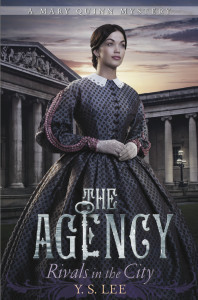Author Math
One of the things I find consistently surprising in historical fiction is how very long it takes to get from one place to another. The Agency novels are set in London between 1858 and 1860. They’re too urban to make use of the railways that criss-crossed England and a shade too early for the first intra-city underground trains (the steam-powered Metropolitan Railway opened in 1863). Most of the travel in my books takes place either on foot or by horse-power: carriages, cabs, and of course, simply riding on horseback. By 1858, there were also horse-drawn omnibuses that, like our present-day buses, plied regular routes through the city.

An early omnibus (image from wikipedia)
The climax of Rivals in the City features a fair amount of running around between locations in central London. One of the first things I did when plotting it was create a chart showing the different sites, the distances between them, and how long it would take to move from one point to another. In order not to spoil the plot (Rivals will be published next week in the U. S. and Canada; it’s already available in the UK), I’ve renamed the locations after four of my favourite North American cities. This, of course, is a fiction upon a fiction; the real locations are London landmarks. Otherwise, here’s what my chart looks like:
Timing the final action
 I assumed an average running speed of about 6 miles/10 km per hour – a pretty fast clip for a woman burdened with heavy clothes on slick, inconsistently paved, and poorly lit urban streets (it’s after dark). But I’m talking about the women of the Agency, an elite detective firm. Not only are they are in excellent physical form, they are responding to an emergency.
I assumed an average running speed of about 6 miles/10 km per hour – a pretty fast clip for a woman burdened with heavy clothes on slick, inconsistently paved, and poorly lit urban streets (it’s after dark). But I’m talking about the women of the Agency, an elite detective firm. Not only are they are in excellent physical form, they are responding to an emergency.
I assumed a horse trot of 7-8 mph, since poor road quality and night-time visibility again make it impossible to canter. With horseback, I also needed to allow tie-up time and the need to rest or change horses. Riding turned out to be not much faster than running, but riding made it possible for a character to arrive at an important location looking respectable.
As it worked out, the time elapsed for a series of important messages to be relayed was:
– 57 minutes: for a character to run from Vancouver to Toronto and back again
– 41 minutes, plus delays while tying-up a horse: for a character to ride from Toronto to New York, and then from New York to Montreal
– 30 to 35 minutes, plus time for marshalling and instructions: for a large group to walk quickly from Montreal to Vancouver
 This left me with a space of 2 ¼ hours, the minimum period of time my heroine, Mary Quinn, would be alone in “Vancouver” after sounding the alarm. It turned out to be the perfect window of time to allow her to take action, imperil herself, yet receive help at just the right moment.
This left me with a space of 2 ¼ hours, the minimum period of time my heroine, Mary Quinn, would be alone in “Vancouver” after sounding the alarm. It turned out to be the perfect window of time to allow her to take action, imperil herself, yet receive help at just the right moment.
I love this kind of concrete plotting, and wonder if any of you do the same. How do you work out timelines, near-misses, and rescues?
(This post was also published yesterday at The History Girls.)



